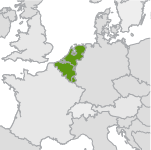Winged glass
Winged Glass
A partly hollow combination merese/avolio construction is added to the tip of a bubble of glass that eventually becomes the bowl (or cup). A complex, multi-part stem and foot are then attached. The vessel is completed while it is held by a pontil.
Transcript
The vessel begins with a small gather of transparent glass on the end of a blowpipe. The glass is marvered and this elongates the gather. Air is blown in. The tip is left thick. After reheating, the rubber blow hose is used to inflate the glass as work is carried out on the end. The glass is inflated, elongated, and a carefully made constriction near the blowpipe will allow the vessel to be broken free of it later in the process.
The lower half is reheated, the jacks held against the side, and blowing continues. This both shapes the lowermost part of the bubble and it blows it a little bit thinner. The bottom has to be just the right diameter for the octagonal mold to work. A substantial gather of glass is added to the tip and, as shaping takes place, air is blown forcefully into the blowpipe. You can see the bubble beginning to form at the end.
A pre-made section of clear glass with a red and a white stripe down the side is attached to the end of a punty. This is thinly gathered over with clear glass. The clear glass rapidly re-softens the pre-formed cane. And this is added to the tip of the avolio at the bottom of the bowl. The glass is cut free of the gathering iron, reheated, centripetal force elongates the mass. The end is flattened. It's folded upon itself, further elongated, and touched to the uppermost part. The end is held, pulled outward, and twisted, touched opposite the first contact point and, after reheating, a loop is formed. The end is heated and pushed upward and with manipulation, a pretzel stem is created. The glass is softened and pressed flat. Aquamarine glass is added to the side, cast free of its gathering iron, and a waffle tool is used to create the decorative pattern.
This is repeated. A tiny amount of freshly gathered glass is added to the tip, cast free, reheated, spun (for centripetal force to elongate the gather), and it's manipulated to form a tiny stem element at the base of the larger part of the stem. A bubble of glass is lowered on to its tip. This will become the foot. And it's cut free of its blowpipe. A narrow constriction is made. This is held with the diamond shears; the tip is broken away, thus leaving a hole in the end of the bubble. After reheating, the hole is dilated. The soffietta is used to cool the lowermost part of the stem.
During the reheating necessary to soften the foot bubble, the stem must be kept stiff and cool. This vessel has a folded edge. With more cooling of the lower part of the stem, and reheating, the foot is given its final shape. Next, comes the transfer to the punty. The tip of the glass on the end of the punty is blown. The constriction held with the pincers, the blowpipe tapped slightly, and the neck breaks. A thinning procedure is used to ensure that the edge of the final vessel is very thin. The soffietta is used to shape the uppermost part of the vessel. Jacks are used to give the vessel a conical form, and the entire cup is softened slightly and pushed forcefully down onto the fin mold. And this creates the octagonal pattern. The vessel is lowered into the annealer, the rod tapped. The punty breaks, leaving the vessel in the annealing oven for slow cooling.
See all: Browse by Map


